Guest Editor, Dr. Alan Ng
1994 World Kyuk Too Ki Heavyweight Bare Knuckle Champion
Second Degree Black Belt Enshin Karate
First Degree Black Belt Shidokan Karate
With the new popularity of athletic activities involving the martial arts, a variety of injuries will occur that are not seen with mainstream athletics. The diversity of the martial arts can be broken down into two different types of training. The traditional martial artist or kickboxer's training will involve a series of activities. A training session will involve stretching, basic techniques and combinations, bag and/or pad training, forms or kata, and finally sparring. A new type of training has become very popular in today's society is aerobic kickboxing otherwise known as "tae Bo". This type of training or exercise involves utilizing martial arts technique combined with traditional aerobic exercises. A class of aerobic kickboxing will combine stretching, basic techniques and combinations in an aerobic type format.
Training
The most important aspect of martial arts training or aerobic kickboxing training is that the student or participant must stretch extensively before a training session. By stretching the amount of minor soft tissue injuries such as muscle strains, tendon strains will be decreased. Stretching should be performed for a minimum of fifteen minutes before performing any kicking or punching techniques.
Injuries that can occur vary from minor injuries to severe dehabilitating injuries. When assessing aerobic kickboxing, injuries that occur are generally minor. Common podiatric related injuries when performing aerobic kickboxing are; plantar fasciitis, Achilles tendonitis, seasmoiditis, ankle sprains. When looking at traditional martial arts which involve striking pads, a heavy bag, and/or another student, the injuries become more extensive. In addition to the injuries mentioned above, traditional martial arts injuries include; fractures, hematomas, and dislocation joints and tendons.
Plantar fasciitis, or plantar fascial injuries can occur when training due to the constant pivoting and elevation of the foot while performing kicks. The mechanics of performing a front or roundhouse type kick involves the supporting leg to pivot on the ball of the foot, while the other leg is in the air striking the target. The fascial injury can occur on the supporting leg due the strain on the fascia, or a fascial injury can occur to the striking leg due to the repetitive pushing off and tightening of the fascia when beginning the kick, or when the kick is concluding which causes the kicking foot return to the ground which causes tightening of the fascia. The pain will be located at the inside of the heel and at the bottom of the heel when this type of injury occurs.
Achilles tendonitis is another common injury during martial arts training. The Achilles tendon is involved bringing the foot into position for many of the kicks, and is also responsible for the initiating motion when performing a kick. Since the amount of kicks performed in a training session can be over 500, an overuse injury to the Achilles tendon can cause a tendonitis when training.
Seasmoiditis, is another type of repetitive motion related injury. When performing kicks properly, the supporting foot is elevated onto its metatarsal heads, which allows the supporting leg to pivot. The long bone behind the big toe has two small round shaped bones underneath the head of this bone. These bones can become irritated and inflamed and cause pain just behind and under the big toe.
As with many other sports, ankle sprains are very common in martial arts training. The abundance of side-to-side motion and one limb support while kicking makes this injury a common one when training.
Basic Treatment Recommendations
With the four injuries listed above, basic treatment of resting the injury, icing the injury, and elevating the extremity should be performed. If the conditions persist after a few days of rest, ice, and elevation, further assessment should be performed by your podiatrist.
Other Injuries
With the addition of contact activities in traditional martial arts, fractures are common in the foot and ankle. Common types of fractures while training are; digital fractures, and metatarsal fractures. With these types of injuries, the pain is severe and often results in the inability to bear weight on the limb. Swelling and bruising will often accompany the fracture. If any injury is severe enough to hinder your ability to walk, and a fracture is suspected, it is recommended that you visit your podiatrist so x-rays of the area can be taken.
Hematoma formation may be the most common injury in the traditional martial artist. Hematoma is caused when the foot or leg strikes the target improperly or strikes a target which is not padded well. Objects such as bony prominences, a hard heavy bag, or even sandbags. What occurs is that by striking this object multiple vascular structures are disrupted causing bleeding inside the foot or leg. This will cause the foot to swell most commonly on the top of the foot, and the swelling causes pressure on the nervous structures which will result in pain. Hematomas can occur with or without fractures of the bones. The primary treatment for this type of injury is again rest, ice, compression, and elevation. It is very important thought to assess this injury properly. If you notice that the toes are cold, and the pain is very severe you must immediately have the injury assessed at a hospital or an urgent care center. A condition called Compartment Syndrome can occur in this area which if not treated immediately, can result in loss of your foot.
Dislocation of joints in martial arts will involve the digits the majority of the time. With traditional martial arts the training is performed without shoe gear. This allows the digits to be exposed and vulnerable to dislocation. If a digit becomes dislocated, see you podiatrist as soon as possible to avoid any long-term complications in that digit.
Tendon dislocation can also occur as a result of martial arts training. The primary tendon which can dislocate when training is the peroneal tendon which runs just behind the fibula. Often times this injury is mistaken for an ankle sprain. The characteristic of this injury is that the tendon which is usually behind the fibula will pop around the outside of the bone when the foot is pushed up. The injury will feel much like an ankle sprain. If you notice the tendon displacing in this way, or you notice that what you thought was an ankle sprain is not getting better you should see your podiatrist for further evaluation.
Conclusion
Martial arts is an excellent method of exercise and stress relief. As with any type of exercise, injuries are a common occurrence. Being able to identify the type of injury, and the proper treatment modality will allow for a faster recovery and a faster return to activity.


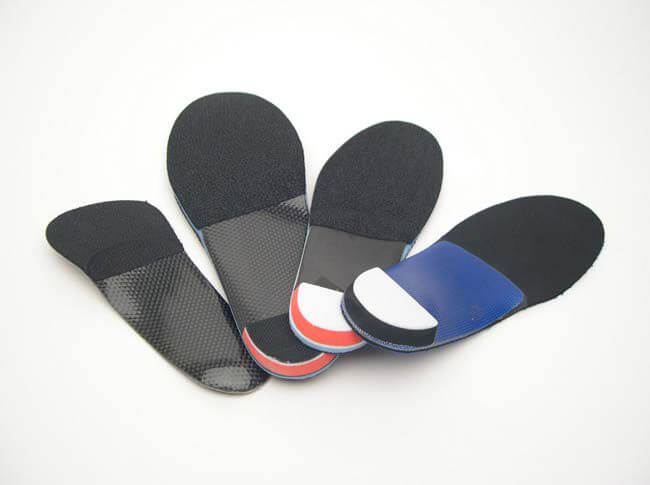
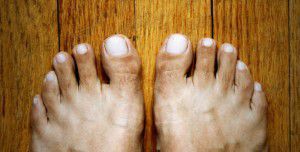 Choose appropriate footwear – If you are active and participate in sports select footwear designed for that specific type of activity. A toe box appropriate for your foot structure is important preventing ingrown toenails and other injuries. Shoes that you wear every day should have plenty of room around your toes. Shoes that you wear for walking briskly or for running should have plenty of room also, but not be too loose.
Choose appropriate footwear – If you are active and participate in sports select footwear designed for that specific type of activity. A toe box appropriate for your foot structure is important preventing ingrown toenails and other injuries. Shoes that you wear every day should have plenty of room around your toes. Shoes that you wear for walking briskly or for running should have plenty of room also, but not be too loose.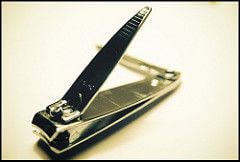 Perfect your cuts – When trimming nails be conscious of how short and curved you trim your nails. The more skin exposed the greater the opportunity the nail has to regrow into the skin. Always use a clean, sharp nail trimmer. When trimming your toenails consider briefly soaking your foot in warm water to soften the nail. Trim toenails straight across the top, do not taper or round the corners or trim too short. Never pick at or tear your nails.
Perfect your cuts – When trimming nails be conscious of how short and curved you trim your nails. The more skin exposed the greater the opportunity the nail has to regrow into the skin. Always use a clean, sharp nail trimmer. When trimming your toenails consider briefly soaking your foot in warm water to soften the nail. Trim toenails straight across the top, do not taper or round the corners or trim too short. Never pick at or tear your nails.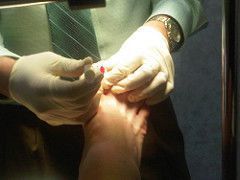
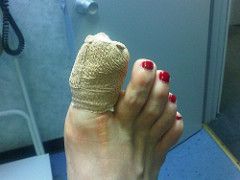
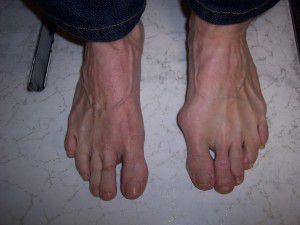
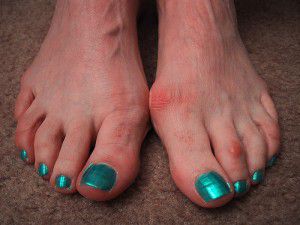 Are you experiencing pain related to a bunion?
Are you experiencing pain related to a bunion?